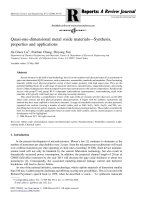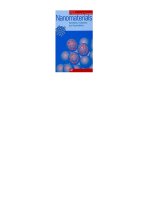Dithiolene chemistry synthesis, properties, and applications (progress in inorganic chemistry vol 52
Bạn đang xem bản rút gọn của tài liệu. Xem và tải ngay bản đầy đủ của tài liệu tại đây (5.61 MB, 725 trang )
DITHIOLENE CHEMISTRY
PROGRESS IN
INORGANIC CHEMISTRY
VOLUME 52
www.pdfgrip.com
Advisory Board
JACQUELINE K. BARTON
CALIFORNIA INSTITUTE OF TECHNOLOGY, PASADENA, CALIFORNIA
THEODORE J. BROWN
UNIVERSITY OF ILLINOIS, URBANA, ILLINOIS
JAMES P. COLLMAN
STANFORD UNIVERSITY, STANFORD, CALIFORNIA
F. ALBERT COTTON
TEXAS A & M UNIVERSITY, COLLEGE STATION, TEXAS
ALAN H. COWLEY
UNIVERSITY OF TEXAS, AUSTIN, TEXAS
RICHARD H. HOLM
HARVARD UNIVERSITY, CAMBRIDGE, MASSACHUSETTS
EIICHI KIMURA
HIROSHIMA UNIVERSITY, HIROSHIMA, JAPAN
NATHAN S. LEWIS
CALIFORNIA INSITITUTE OF TECHNOLOGY, PASADENA, CALIFORNIA
STEPHEN J. LIPPARD
MASSACHUSETTS INSTITUTE OF TECHNOLOGY, CAMBRIDGE,
MASSACHUSETTS
TOBIN J. MARKS
NORTHWESTERN UNIVERSITY, EVANSTON, ILLINOIS
EDWARD I. STIEFEL
PRINCETON UNIVERSITY, PRINCETON, NEW JERSEY
KARL WIEGHARDT
ă LHEIM, GERMANY
MAX-PLANCK-INSTITUT, MU
www.pdfgrip.com
DITHIOLENE CHEMISTRY
Synthesis, Properties, and Applications
Special volume edited by
EDWARD I. STIEFEL
Department of Chemistry, Princeton University
Princeton, New Jersey
PROGRESS IN
INORGANIC CHEMISTRY
Series edited by
KENNETH D. KARLIN
Department of Chemistry, Johns Hopkins University
Baltimore, Maryland
VOLUME 52
AN INTERSCIENCE PUBLICATION
JOHN WILEY & SONS, INC.
www.pdfgrip.com
Copyright # 2004 by John Wiley & Sons, Inc. All rights reserved.
Published by John Wiley & Sons, Inc., Hoboken, New Jersey.
Published simultaneously in Canada.
No part of this publication may be reproduced, stored in a retrieval system, or transmitted in any
form or by any means, electronic, mechanical, photocopying, recording, scanning, or otherwise,
except as permitted under Section 107 or 108 of the 1976 United States Copyright Act, without either
the prior written permission of the Publisher, or authorization through payment of the appropriate
per-copy fee to the Copyright Clearance Center, Inc., 222 Rosewood Drive, Danvers, MA 01923,
978-750-8400, fax 978-646-8600, or on the web at www.copyright.com. Requests to the Publisher
for permission should be addressed to the Permissions Department, John Wiley & Sons, Inc.,
111 River Street, Hoboken, NJ 07030, (201) 748-6011, fax (201) 748-6008.
Limit of Liability/Disclaimer of Warranty: While the publisher and author have used their best
efforts in preparing this book, they make no representations or warranties with respect to the
accuracy or completeness of the contents of this book and specifically disclaim any implied
warranties of merchantability or fitness for a particular purpose. No warranty may be created or
extended by sales representatives or written sales materials. The advice and strategies contained
herein may not be suitable for your situation. You should consult with a professional where
appropriate. Neither the publisher nor author shall be liable for any loss of profit or any other
commercial damages, including but not limited to special, incidental, consequential, or other
damages.
For general information on our other products and services please contact our Customer Care
Department within the U.S. at 877-762-2974, outside the U.S. at 317-572-3993 or fax 317-572-4002.
Wiley also publishes its books in a variety of electronic formats. Some content that appears in print,
however, may not be available in electronic format.
Library of Congress Catalog Card Number 59-13035
ISBN 0-471-37829-1
Printed in the United States of America
10 9 8
7 6 5 4
3 2 1
www.pdfgrip.com
Dieter Sellmann
(1941–2003)
With the agreement of all of the authors, this volume is dedicated to our
colleague Dieter Sellmann, who died unexpectedly shortly after completing his
contribution to this book. Dieter was a marvelous synthetic chemist whose
beautiful molecules are amply displayed in Chapter 11 (written with Joă rg Sutter)
of this collection. But, Dieter was more than someone who created novel and
beautiful molecules. He brought insight and understanding to these structures
and, especially, to their reactivity with important small molecules. He was
inspired by biology, by the reactions of nitrogenase, and by nitrogen oxide
interconversions. Indeed, some of his synthetic creations laid bare the possibilities of binding of reactive intermediates in glorious detail, about which others
could only speculate. His molecules will continue to give us important clues
about the reactivity of enzymes and other catalytic systems. We will miss
Dieter’s creativity, insights, and good humor, but we also remember and honor a
life of great scientific accomplishment, which his article in this volume
beautifully represents.
Dieter was an outstanding scientist, a wonderfully warm and vibrant human
being, and a good friend. He will be sorely missed.
v
www.pdfgrip.com
Preface
This volume of Progress in Inorganic Chemistry documents the intense
current interest and bright future prospects for research on the chemistry and
uses of dithiolene complexes. Over the last forty years, complexes of these
remarkable ligands have gone from an important and interesting subclass of
inorganic coordination chemistry to a field that, while generating continued
interest in structure, bonding, and reactivity, now has impact on a far larger
stage. The findings that dithiolene complexes have useful reactivity and sensing
properties, that they are at the core of a large number of biologically essential
enzymes, and that they display remarkable (super)conductivity, optical, and
magnetic properties in the solid state, together have given great impetus to work
in this field. These new and, in many cases, quite unexpected findings are
documented in this volume side by side with continued discussions of the basic
synthetic, structural, spectroscopic, bonding, and reactivity properties of the
complexes. The size and scope of this volume and the quality of the individual
contributions reveal a vital field that is just entering its prime. It is our hope that,
by collecting comprehensive reviews on the various subfields of dithiolene
chemistry in a single place, we will contribute toward the stimulation of this
now burgeoning field of interdisciplinary research.
Although there had been some very early work (pre-1960) on the use of
certain dithiolene ligands in quantitative analysis of metal ions, these initial
studies were largely empirical and never explored the highly colored complexes
at the structural level. The modern era of dithiolene research started in the early
1960s with contributions from three research groups: those of Schrauzer and
co-workers (at Munich and the University of California at San Diego); Gray and
co-workers (at Columbia); and Davison and Holm and co-workers (at Harvard).
The combined work of these research groups first established the square-planar
nature, redox activity, and broad scope of the highly colored bis(dithiolene)
complexes of the late transition metals. From the outset, there was contention
about the electronic structures of these complexes, as the redox capacity of the
ligands (i.e., their noninnocence) made the assignment of oxidation state
difficult, or, in some cases, ambiguous, at best. Interest in the area was further
heightened by the synthesis and structural characterization of the tris(dithiolene)
complexes of early transition metals. In addition to sharing the unusual properties of the bis complexes, members of the tris(dithiolene) family were shown to
be the first molecular examples of trigonal-prismatic coordination by Eisenberg
and Ibers (at Columbia and Brookhaven).
vii
www.pdfgrip.com
viii
PREFACE
Work on dithiolene chemistry continued through the 1960s and 1970s fueled
by continued interest in the remarkable coordination chemistry of dithiolene
complexes. However, in the last 20 years tremendous added impetus to research
in the area arose from discoveries in materials science, enzymology, analytical
science, and reactivity that broadened the impact and import of dithiolene
chemistry. This volume seeks to capture the interplay of basic work on
dithiolene complexes with the growing biological, sensor, reactivity, and
materials science implications and applications that have made dithiolene
chemistry a vibrant and growing field.
Chapter 1 deals with synthesis, where we learn that there are many ways to
make dithiolene complexes, either from preformed ligands or through the
chemical reactivity of bound sulfur species. Synthesis is at the core of most
of the coordination chemistry that has been done on dithiolene complexes.
Chapter 2 deals with structures and structural trends of the most common simple
dithiolene complexes. Indeed, it was the square-planar nature of most late
transition metal bis(dithiolene) complexes and the unprecedented trigonalprismatic six-coordination of some of the tris(dithiolene) complexes that was
one of three major drivers for early work in the field.
In addition to structure, early work was also driven by two other prominent
features: electronic structural uniqueness and one-electron redox activity. The
second major driver, the electronic structural uniqueness of dithiolene complexes of the transition metals, was manifested in their highly colored nature
(i.e., large extinction coefficients). This feature lead to extensive spectroscopic,
magnetic, and theoretical studies, which continue through the present with great
intensity. Electronic structural studies, reviewed in Chapter 3, reveal the many
intricate and interesting features of dithiolene complexes, including the oxidation state ambiguity that can arise from the noninnocence of the ligands.
Chapter 4 deals explicitly with the vibrational spectroscopy (IR and Raman),
where the spectra are extremely valuable in probing the binding in the ligands
and complexes. The material in Chapters 3 and 4 also show the great utility of
the spectroscopic and computational tools in probing the molybdenum and
tungsten dithiolene cofactors found in biological systems.
The third feature of dithiolene chemistry that attracted early attention was the
chemical and electrochemical one-electron redox reactivity of the complexes,
which allowed a given complex stoichiometry (M/L ratio) to be isolated with
several different charges (i.e., different states of oxidation, albeit not necessarily
different oxidation states of the metal). Chapter 5 deals with the electrochemical
and chemical reactivity of dithiolene complexes, wherein it is seen that the
chemical reactivity goes beyond simple redox reactivity and includes reactions
that are often ligand, rather than metal, based.
Chapters 6 and 7 show how the unique electronic structural features of
dithiolene complexes manifest themselves in luminescent and photochemical
behavior. Chapter 6 reveals that the excited states of dithiolene complexes and
www.pdfgrip.com
PREFACE
ix
their photochemistry can be understood in those cases where the luminescent
activity can be dissected in detail. Chapter 7 describes particular examples
wherein the luminescent behavior has been exploited in the development of
effective sensors for molecular oxygen and, with great promise, for other
molecules as well.
Chapter 8 reviews the considerable work that has been done on solid-state
systems. These systems combine the structural features of planar dithiolene
complexes, wherein specifically discovered and/or designed ligands form complexes that coalesce into extended lattices, with unusual conductive, magnetic,
and/or optical properties. The extensive interest in this field is nurtured by the
truly unusual nature of the extended structures, which, in turn, clearly exploit
some of the unique structural and electronic structural features of the simpler
dithiolene complexes.
Chapters 9 and 10 deal with our now extensive knowledge of dithiolene centers
in molybdenum and tungsten enzymes and in their chemical model systems,
respectively. Chapter 9 introduces the families of molybdenum and tungsten
enzymes that contain the pyranopterin dithiolene ligand, reveals the array of
reactions catalyzed by these enzymes, and describes the active site protein structures that have come to light in recent years through X-ray crystallography. The
enzyme work provides great impetus and added importance to studies of model
systems outlined in Chapter 10. Work on these simpler systems reveals structural
trends, electronic structural details, and reactivity modes that are essential to the
full understanding of the structures, spectra, and reactivity of the enzymes, many of
which are important in medical, agricultural, and environmental systems.
Last, but not least, Chapter 11 reveals how the dithiolene unit has been used as
a building block to construct more complex organic ligands. These ligands form a
remarkable variety of novel complexes (see dedication) that display new forms of
reactivity, which may yet reveal ways in which important small molecules are
activated and converted by enzyme systems in the transition metal dithiolene
family.
The 11 chapters in this volume reveal a vigorous field that may just be
entering its prime. The new results from synthesis, structure elucidation,
spectroscopy, biology, bioinorganic chemistry, analytical science, solid-state
materials chemistry, and reactivity define a rich field that has far to go before
reaching maturity. It is also clear that, as we learn more about dithiolene
complexes, we will see new applications arising that exploit our fundamental
understanding of chemical, material, and biological systems. It is our hope that
this monograph, by bringing together the myriad aspects of dithiolene chemistry
in a single volume, will serve as a comprehensive archival reservoir, stimulate
further advancement of the field, and impel its growing interface with diverse
areas of science and technology.
Princeton, New Jersey
EDWARD I. STIEFEL
www.pdfgrip.com
Contents
Chapter 1
Synthesis of Transition Metal Dithiolenes
T. B. Rauchfuss
Chapter 2
Structures and Structural Trends in Homoleptic
Dithiolene Complexes
C. L. Beswick, J. M. Schulman, and E. I. Stiefel
1
55
Chapter 3
The Electronic Structure and Spectroscopy of
Metallo-Dithiolene Complexes
111
M. L. Kirk, R. L. McNaughton, and M. E. Helton
Chapter 4
Vibrational Spectra of Dithiolene Complexes
M. K. Johnson
Chapter 5
Electrochemical and Chemical Reactivity
of Dithiolene Complexes
K. Wang
267
Luminescence and Photochemistry of Metal
Dithiolene Complexes
S. D. Cummings and R. Eisenberg
315
Metal Dithiolene Complexes in Detection:
Past, Present, and Future
K. A. Van Houten and R. S. Pilato
369
Solid-State Properties (Electronic, Magnetic, Optical)
of Dithiolene Complex-Based Compunds
C. Faulmann and P. Cassoux
399
Chapter 6
Chapter 7
Chapter 8
213
Chapter 9
Dithiolenes in Biology
S. J. N. Burgmayer
Chapter 10
Chemical Analogues of the Catalytic Centers of
Molybdenum and Tungsten Ditholene-Containing Enzymes 539
J. McMaster, J. M. Tunney, and C. D. Garner
xi
491
www.pdfgrip.com
xii
Chapter 11
CONTENTS
Dithiolenes in More Complex Ligands
D. Sellmann and J. Sutter
585
Subject Index
683
Cumulative Index, Volumes 1–52
723
www.pdfgrip.com
CHAPTER 1
Synthesis of Transition Metal Dithiolenes
THOMAS B. RAUCHFUSS
School of Chemical Sciences
University of Illinois at Urbana-Champaign
Urbana, IL
CONTENTS
I. INTRODUCTION
2
II. SYNTHESIS FROM PREFORMED ALKENEDITHIOLATES,
1,2-DITHIONES, OR THEIR EQUIVALENT
A.
B.
C.
D.
From Benzenedithiol and Related Derivatives / 4
1. Arene Derivatives / 4
2. Linked Bis(benzenedithiolate) Complexes / 8
3. Heterocyclic and Heteroatomic Dithiolates / 10
From 1,2-Alkenedithiolates / 10
1. Via Reductive Dealkylation / 10
2. By Base Hydrolysis of Dithiocarbonates (Dithiole-2-ones) and
Related Derivatives / 11
From Selected 1,2-Alkenedithiolate Dianions / 15
1. 4,5-Dimercapto-1,3-dithiole-2-thione (dmit2À) / 15
2. Inorganic Dithiolates Related to dmit2À / 17
3. Tetrathiafulvalene (TTF)-Derived Dithiolenes / 19
4. From the Thiacarbons [CnSn]2À and Related Derivatives / 20
5. 1,2-Maleonitrile 1,2-dithiolate (mnt2À) / 21
Via Thiophosphate Esters (from a-hydroxyketones and a-diketones) / 21
Dithiolene Chemistry: Synthesis, Properties, and Applications,
Progress in Inorganic Chemistry, Vol. 52
Special volume edited by Edward I. Stiefel, Series editor Kenneth D. Karlin
ISBN 0-471-37829-1 Copyright # 2004 John Wiley & Sons, Inc.
1
4
www.pdfgrip.com
2
THOMAS B. RAUCHFUSS
E.
F.
G.
From 1,2-Dithietes / 22
From 1,2-Dithiones, Including Dithiaoxamides and Esters of Tetrathiaoxalate / 23
Via Intermetallic Dithiolene Transfer / 25
1. Non-Redox Routes / 25
2. Redox Routes / 26
III. TRANSITION METAL PROMOTED ROUTES TO DITHIOLENES
A.
B.
C.
D.
E.
F.
29
Addition of Electrophilic Alkynes to Metal Sulfides / 29
Addition of Unactivated Alkynes to Metal Sulfides / 32
From Metal Sulfides and a-Haloketones and Related Precursors / 37
By Dehydrogenation of Alkanedithiolates / 38
From Dithiocarbonates / 39
Specialized Routes to Dithiolenes / 40
1. S-Dealkylation / 40
2. Insertion into Metal–Alkyne Bonds / 41
3. CÀ
ÀC Coupling Pathways / 42
4. From Alkynes and Thiocarbonyl Derivatives / 43
5. Dithiolene Coupling / 43
6. From Alkynyl Anions / 44
IV. SUMMARY AND OUTLOOK
44
ACKNOWLEDGMENTS
44
ABBREVIATIONS
44
REFERENCES
45
I.
INTRODUCTION
Research on metal dithiolenes has remained continuously active since its
inception in the early 1960s. Initially, the area was driven by the distinctive
redox and structural characteristics of these coordination compounds. After this
discovery phase, dithiolene chemistry was fueled by its connections to materials
science with respect to photonics and electronic conductors. These developments paralleled growth in the area of organic metals; in fact, the preparative
chemistry of dithiolene complexes has greatly benefited from advances in
tetrathiafulvalene chemistry (1). This direction remains active (2, 3). In the
1990s, research on dithiolenes was energized by recognition that virtually all
Mo- and W-containing enzymes feature dithiolene ligands, which are in turn
incorporated into the heterocyclic pyranopterins (4–7). Parallel with the aforementioned developments—discovery, materials-driven studies, and biologically
driven studies—dithiolene complexes continue to appear in many contexts,
often unexpected ones, due to the great stability of the MS2C2R2 ring.
www.pdfgrip.com
SYNTHESIS OF TRANSITION METAL DITHIOLENES
3
This chapter discusses the synthesis of transition metal dithiolene complexes
and is current to late 2002. Dithiolene chemistry has been reviewed several
times previously, but this is the first review dedicated to synthetic aspects.
Emphasis is placed on more contemporary methods, and the reader should
consult the older reviews, especially those by Mueller-Westerhoff et al. (8) and
McCleverty (9) for discussions of earlier literature. An effort was made to be
comprehensive with respect to methods and the range of complexes examined,
but the chemistry of metal dithiolenes is so vast that it is not practical to be
exhaustive.
In this chapter, the term dithiolene refers to a ligand of the formula R2C2S2,
which depending on one’s formalism could be described as an alkene-1,2dithiolate dianion, a 1,2-dithione, or some oxidation state between these two
extremes (Fig. 1). Benzenedithiolates, their derivatives, and analogues are also
included.
This chapter is divided into two main parts. The first part focuses on reactions
where the dithiolene ligand is generated independently of the metal center. For
the most part, these preparations give alkenedithiolate dianions, which ordinarily are treated with metal electrophiles to form dithiolene complexes. In
the second part, transition metals actively participate in the assembly of the
dithiolenes, usually via the reaction of a metal sulfido species with an alkyne or
hydrocarbon in an equivalent oxidation state.
When considering the synthesis of a dithiolene complex, it is essential to bear
in mind that dithiolenes vary widely in their electronic properties. If one simply
seeks an unsaturated chelating dithiolate, the most convenient options are
benzenedithiolate and the inorganic dithiolenes 1,3-dithiole-2-thione-4,5-dithiolate (dmit2À) and 1,2-maleonitrile-1,2-dithiolate (1,2-dicyanoethene-1,2-dithiolate) (mnt2À). Large-scale syntheses of these ligands are available. Dithiolenes
Figure 1. Relationships and nomenclature for common dithiolene precursors.
www.pdfgrip.com
4
THOMAS B. RAUCHFUSS
such as mnt2À and dmit2À that have electronegative substituents behave like
bidentate pseudohalides, and their complexes are usually synthesized via simple
salt metathesis reactions. Akyl-substituted dithiolenes (e.g., [Me2C2S2]2À),
are powerful p donors, useful for stabilizing metals in high formal oxidation
states. Syntheses of complexes of such strongly donating dithiolenes often
require redox steps after the initial formation of a metal dithiolene complex.
II.
SYNTHESIS FROM PREFORMED ALKENEDITHIOLATES,
1,2-DITHIONES, AND THEIR EQUIVALENT
A.
From Benzenedithiol and Related Derivatives
1.
Arene Derivatives
Arene-1,2-dithiols are completely stable and are valuable precursors to
dithiolene complexes. Benzenedithiol is the most common member of this class
of ligands, but related derivatives include toluene-3,4-dithiol (10), 3,4,5,6tetrachlorobenzenedithiol (11), 3,4,5,6-tetramethylbenzenedithiol (12), 2,3naphthalenedithiol (13), and quinoxalinedithiol (14) (Fig. 2).
Benzenedithiols are traditionally prepared by reductive dealkylation of 1,2C6R4(SR0 )2, which in turn are obtained by treatment of dibromobenzenes with
alkali metal or cuprous thiolates. The methodology continues to be used, for
example, for crown ether-appended derivatives (15). A newer and more powerful synthesis of 1,2-benzenedithiol and its derivatives has been developed (16).
This method (17) involves reaction of the benzenethiol with 2 equiv of BuLi to
give 2-LiC6H4(SLi), which reacts with elemental sulfur to give the dithiolate
(Eq. 1).
SH
1) BuLi
2) S8
3) H+
SH
ð1Þ
SH
This method has been extended to the synthesis of the bulky benzenedithiol 3(Ph3Si)C6H3-1,2-(SH)2 (18) as well as a series of mixed chalcogenides such as
[1,2-C6H4(S)(Te)]2À (19).
Typically, transition metal benzenedithiolates (and related derivatives) are
prepared by the following methods: salt elimination reactions using a metal
halide and the dithiolate dianion, thiol exchange, and condensation of the free
thiol with oxo, alkoxo, and amido precursors. In one example, the dithiol was
www.pdfgrip.com
SYNTHESIS OF TRANSITION METAL DITHIOLENES
5
Figure 2. Structures of important arenedithiolate and related ligands.
treated with a metal methyl compound concomitant with the elimination of
methane (Eq. 2) (20).
WMe6 ỵ 3 C6 H4 SHị2 ! WS2 C6 H4 ị3 ỵ 6 CH4
2ị
Homoleptic dithiolene complexes, for example, [Ni(S2C6R4)2]z and
[M(S2C6R4)3]z (M ¼ Mo, W), are generally prepared by reaction of the metal
halide and the dithiolate, often followed by oxidation of the initially formed
complexes. An illustrative study is the synthesis of [Ni(S2C6H2(t-Bu)2)2]2À,
which can be oxidized to the monoanion and neutral derivatives using air and
iodine, respectively (21). Reactions of MoCl5 and WCl6 with the benzenedithiolate salts give M(S2C6R4)3 (15, 22) or reduced derivatives. Similarly,
treatment of Ti(NMe2)4 with C6H4(SH)2 gives (NMe2H2)2[Ti(S2C6H4)3],
wherein the amido ligand serves not only as a proton acceptor but also generates
the countercation (23). The tris(dithiolenes) are so robust and so easily
formed that they plague syntheses of the oxo-dithiolenes [MO(S2C6R4)2]z
(24). In the case of Mo derivatives, the metathetical reactions can be conducted
www.pdfgrip.com
6
THOMAS B. RAUCHFUSS
[WO(SPh)4]-
C6H4(SH)2
[WO(S2C6H4)2]BH4-
[WO2(S2C6H4)2]2Figure 3.
Me3NO
[WO(S2C6H4)2]2-
Illustrative syntheses of oxo-tungsten dithiolenes (25).
in the presence of donor ligands, which inhibit the formation of the tris(dithiolene) complexes. For example, treatment of Na2(S2C6R4) with MoCl4(MeCN)2
in the presence of donor ligands L affords Mo(S2C6R4)2L2 (L ¼ PPh2Me or
MeNC; R ¼ H, Me) (12). These derivatives are closely related to the corresponding dicarbonyls (L ¼ CO; see Section II.G.2).
Compounds of the type [MO(S2C6H4)2]nÀ (M ¼ Mo, W) have received much
attention. A direct approach to [WO(S2C6H4)2]À proceeds via the reaction of
WOCl3(thf)2 (where thf ¼ tetrahydrofuran) benzenedithiol, and Et3N (24). Alternatively, thiol exchange routes can be advantageous as a means to minimize
redox processes and formation of [M(S2C6H4)3]nÀ. For example, [WO(SPh)4]À
and benzenedithiol give [WVO(S2C6H4)2]À, which can be subsequently reduced
with NaBH4 to give [WIVO(S2C6H4)2]2À (Fig. 3) (25). Related thiol exchange
reactions involve conversion of [MoO(SC6H4R)4]nÀ (R ¼ Cl, n ¼ 2; R ¼ H,
n ¼ 1) into [MoO(S2C6H3R)2]nÀ (R ¼ H, Me, Ph3Si) (18, 26).
The oxo-bis(dithiolenes) are amenable to further reactions. Treatment of
[MO(S2C6H4)2]2À Me3NO (13) affords [MVIO2(S2C6H4)2]2À (M ¼ Mo, W)
(25, 27). Silylation of the oxo-bis(dithiolene) complexes gives [MVI(OSiR3)(S2C6H4)2]À (M ¼ Mo, W), which are versatile precursors to diverse coordination sets on the bis(dithiolene) framework (12, 24). For example, such
[MVI(OSiR3)(S2C6H4)2]À derivatives can be oxidized using Me3NO to give
[MVI(O)(OSiR3)(S2C6H4)2]À (M ¼ Mo, W) and, in the W case, sulfided using
dibenzyltrisulfide to give [WVI(S)(OSiR3)(S2C6H4)2]À.
The mildly electrophilic complex MeReO3 condenses with 2 equiv of
benzenedithiol to give MeRe(O)(S2C6H4)2 (28), a rare alkyl metal dithiolene.
Thiol exchange has been employed to probe the strength of metal ligand
bonds as illustrated by the reactions of dicysteinyl peptide-bound derivatives of
[Fe2S2(SR)4]2À with toluene-3,4-dithiol. For strongly chelating dipeptides,
[Fe(SR)2(S2C6H3Me)]À derivatives (R ¼ protein) form with H2S elimination,
whereas less strongly chelating dipeptides are displaced by this dithiol to give
[Fe2S2(S2C6H3Me)2]2À (29).
Since several molybdoenzymes feature a single dithiolene ligand active site
(30), the synthesis of monodithiolene complexes has been of interest. Two
general approaches can be envisioned. Stepwise installation of dithiolene
www.pdfgrip.com
SYNTHESIS OF TRANSITION METAL DITHIOLENES
O
S
7
_
S
Mo
S
S
PhSeCl
_
O
S
Mo
S
Cl
Et3N/Et4NOH
S
S
O
Mo
Mo
O
RS
_
O
2-
O
O
Cl
S
S
Mo
S
S
SR
SR
RS = 2,4,6-(i-Pr)3C6H2S
adamantyl-2-S
Figure 4. Routes to monodithiolene derivatives of Mo (30).
ligands or removal of dithiolenes from bis- and tris(dithiolene) precursors.
One dithiolene can be removed from [MoO(S2C6H4)2]À using PhSeCl to
give monodithiolene [MoOCl2(S2C6H4)]À together with (PhSeS)2C6H4 (30).
The chloro ligands in [MoOCl2(S2C6H4)]À undergo ready substitution to give
diverse mixed-ligand derivatives as shown in Fig. 4. Thiolate–siloxide exchange
was employed to prepare [MoO2(OSiPh3)(S2C6H4)]À via the reaction of
MoO2(OSiPh3)2 with Li2S2C6H4.
Benzenedithiolates can also be prepared by H2 elimination when using lowvalent precursor complexes (Eq. 3) (31).
Cp2 V ỵ C6 H4 SHị2 ! Cp2 VS2 C6 H4 ỵ H2
3ị
This H2-elimination route from 1,2-benzenedithiol was also employed in the
synthesis of Fe2(S2C6H4)(CO)6 (32) and the coordinatively unsaturated [Mn(CO)3(S2C6H4)]À (33). A series of related coordinatively unsaturated species
[Cr(CO)3(S2C6R4)]2À (R ¼ H, Cl, Me) were prepared by displacement of the
www.pdfgrip.com
8
THOMAS B. RAUCHFUSS
(OC)2(NC)Fe
-
H
N
S
2Fe2(CO)9
C6H4(SH)2
C6H4(SH)2
S
S
Fe(CO)2(CN)
(CO)2(CN)Fe
Et 4NCN
S
S
S
S
Fe(CO)3
(OC)3Fe
Et4NCN
2(OC)(NC)2Fe
S
2-
-CO
S
(OC)2(NC)2Fe
S
S
+CO
Figure 5. Synthetic routes to Fe(S2C6H4)–CO complexes (38, 39).
solvento ligands from Cr(CO)3(MeCN)3. At higher metal stoichiometry, one
obtains the binuclear [Cr2(CO)6(m-CO)(m-Z2:Z2-S2C6R4)]2À (34). Other coordinatively unsaturated dithiolenes have been prepared by salt-forming methods,
for example, [triphos]Fe(S2C6H4) (35), [Z4-C4Me2(t-Bu)2]Pd(S2C6H4) (36), and
(C5Me5)Ir(S2C6H4) (37). The species Fe2(S2C6H4)(CO)6 undergoes ready degradation upon treatment with Et4NCN, giving rise to both mono- and diiron
derivatives (Fig. 5) (38).
2.
Linked Bis(benzenedithiolate) Complexes
Relatively elaborate benzenedithiol ligands have been prepared via ortho
lithiation of 1,2-benzenedithiol with 3 equiv BuLi, which affords 3-LiC6H3(SLi)2. This trilithiated compound undergoes carbonation to give 2,3-dimercaptobenzoic acid. This carboxy-functionalized dithiolene can be linked via amide
formation to give the bis(benzenedithiol), isolated as its Cp2TiIV derivative (see
also Section II.G.1) (40, 41). Such ligands can be converted to chelating
bis(dithiolene) complexes (Fig. 6). The use of 2,3-dimercaptobenzoic acid
derivatives is inspired by the naturally occurring chelators derived from 2,3dihydroxybenzoate (42).
An improved and very promising methodology to such linked dithiolenes
begins with the ortho lithiation of 1,2-C6H4(S-i-Pr)2, generated on a large scale
www.pdfgrip.com
SYNTHESIS OF TRANSITION METAL DITHIOLENES
9
CH2OH
SH
SH
S-i- Pr
1) PBr3
2) Mg
3) Na/C10H8
SH
S-i- Pr
SH
(CH2O)n
Li
Cl NaS-i- Pr
S-i- Pr
Cl
S-i-Pr
S-i- Pr
BuLi
S-i- Pr
CO2
O
HS
HS
NH
NH
CO2H
O
SH
SH
1) SOCl2
S-i- Pr
2) C2H4(NH2)2
3) Na/C10H8
S-i- Pr
Figure 6. Hahn’s methodology to bis(benzenedithiolates).
from 1,2-C6H4Cl2, to give the versatile nucleophile 3-LiC6H3-1,2-(S-i-Pr)2 (43).
This revised metalation procedure was employed in the synthesis of the
ethylene-linked dithiolene 1,2-C2H4[3-C6H3-1,2-(SH)2]2, which forms bimetallic complexes with a staircase-like structure (Fig. 7).
È Â
à É4À
Figure 7. Structure of Ni2 ðS2 C6 H3 Þ2 C2 H4 2
(40).
www.pdfgrip.com
10
THOMAS B. RAUCHFUSS
3.
Heterocyclic and Heteroatomic Dithiolates
Heterocyclic analogues of benzenedithiolates are also available. 3,4-Thiophene-dithiolate is generated from the corresponding dibromothiophene (44).
The isoelectronic but inorganic 1,2,5-thiadiazole-3,4-dithiolate, [SN2C2S2]2À
(tdas, see Fig. 2) can be prepared by sulfidation of SN2(CCl)2; the dianion forms
bis(chelate) derivatives of Ni(II) and Fe(III) (45).
Complexes of 1,10 -ferrocenedithiolate ([FcS2]2À) exhibit properties like
arenedithiolates, one difference being the potential for dative Fe ! M bonding
(46). Ferrocenedithiol and its salts are well known and have been widely
employed as ligands. Some illustrative complexes are Ni(S2Fc)(PMe2Ph) (47)
and TpRe(O)[S2Fc] (48). The olefin polymerization precatalysts FcS2M(NMe2)2
(M ¼ Ti, Zr) were prepared by treatment of M(NMe2)4 with Fc(SH)2,
concomitant with elimination of HNMe2 (49). 1,2,10 ,20 -Ferrocenetetrathiol
(50) could in principle be employed for the synthesis of multimetallic
derivatives.
1,2-Dicarboranedithiolate can be generated by deprotonation of 1,2-dicarborane followed by sulfidation (51–53). The resulting Li2S2C2B10H10 reacts with
metal dihalides to give the corresponding dithiolates.
B.
1.
From 1,2-Alkenedithiolates
Via Reductive Dealkylation
In contrast to arenedithiols, 1,2-alkenedithiols are usually unstable. The
corresponding alkenedithiolate dianions are, however, valuable precursors to
dithiolene complexes, although they vary widely in their ease of manipulation.
Salts of the required cis-[C2R2S2]2À can be generated by the reductive cleavage
of cis-1,2-bis(benzylthio)alkenes using Na/NH3 (few alkali metal salts of
dithiolenes have in fact been characterized in any detail). The reductive dealkylation was discussed above as a route to benzene- and thiophenedithiolates
(15, 43, 44).
Generally speaking, alkenedithiolates derived by this dealkylation route are
strongly reducing and should be handled with complete exclusion of oxidants
and electrophiles (e.g., chlorinated solvents, water). After their isolation as
solids, the disodium dithiolates are generally treated with the metal halide to
give the corresponding dithiolene complexes. In some cases, intermediate
anionic dithiolene complexes are allowed to undergo oxidation by air or solvent
prior to isolation of the final complex. Illustrative is the traditional route to the
M(S2C2H2)n complexes (M ¼ Ni, n ¼ 2; M ¼ Mo, n ¼ 3) (54, 55), the synthesis
of which begins with the Na/NH3 cleavage of cis-1,2-bis(benzylthio)ethene,
www.pdfgrip.com
SYNTHESIS OF TRANSITION METAL DITHIOLENES
11
which can be made on a large scale from cis-dichloroethene and benzylthiolate
salts (56). Solutions of cis-C2R2S2Na2 are treated with divalent metal salts (e.g.,
Ni, Co, Fe, Cu) to give intermediate anionic species that are subsequently
oxidized to give neutral or monoanionic complexes. Third-row metal centers
resist reduction, thus treatment of (C5Me5)TaCl4 with cis-C2H2S2Na2 gives the
expected (C5Me5)Ta(S2C2H2)2 (57). The compound cis-1,2-C2H2[SC(O)Me]2,
prepared by treatment of cis-1,2-C2H2(SNa)2 with acetyl chloride (54, 58), is a
promising if untested precursor to the dithiolene dianion (55). The reductive
cleavage of the corresponding trans-1,2-bis(benzylthio)ethene gives trans-C2H2(SNa)2, which does not normally form molecular complexes (55) (a complex
derived from a trans-alkenedithiolate is described in Section III.F.3). The
cleavage of benzylthioethers has more recently been used to generate nonplanar
dithiolene ligands shown in Eq. 4 (59).
OMe
PhCH2S
MeO
PhCH2S
S
1) Na/NH3
2) MCl2L2 or
NiCl2, air oxidation or
MoCl5, air oxidation
MeO
M
S
n
MeO
M = Ni(PR3)2, Pd(b py); n = 1
M = Ni; n = 2
M = Mo, n = 3 (2 isomers)
ð4Þ
Because of the nonplanarity of these dithiolenes, the Mo(dithiolene)3 derivative
exists as two isomers, one with C3 symmetry and the other with Cs symmetry.
2.
By Base Hydrolysis of Dithiocarbonates (Dithiole-2-ones)
and Related Derivatives
A powerful route to dithiolene complexes employs alkenedithiolate dianions
generated by the hydrolysis of cyclic unsaturated dithiocarbonates, which are
formally called 1,3-dithiole-2-ones. Representative of the many examples (60),
the base hydrolysis route has been used to prepare the ferrocene-substituted
dithiolene Ni[S2C2H(C5H4)FeCp]2 (61), the sulfur-rich dithiolene [Ni(S2C2S2C2H4)2]À (62), the cyano(dithiolenes) trans-{Ni[S2C2H(CN)]2}n (n ¼ 1, 2) (63),
2,3-thiophenedithiolates [Au(S2C4H2S)2]À (64), and the tris(styryldithiolate)
www.pdfgrip.com
12
THOMAS B. RAUCHFUSS
Br
R2
S
R1
O
S
O
S
S
O
Me2CHOCS2R2
R2
OCHMe2
S
R2
R1
AIBN
R2
S
1) OR-
S
MLn
O
S
R1
O
R1
S
2) Ln MX2
R1
S
AIBN = azoisobutyrylnitile
Figure 8. Synthetic routes to alkene dithiocarbonates (dithioles) and their conversion to dithiolene
complexes.
Mo[S2C2H(Ph)]3 (65). As is typical throughout dithiolene chemistry, initially
produced anionic dithiolene complexes are often allowed to undergo airoxidation to give more conveniently isolated derivatives, for example, of the
type [Ni(S2C2R2)2]À and Mo(S2C2R2)3.
The required 1,3-dithiol-2-ones can be prepared in several ways. Commonly
used precursors are a-haloketones, which are often commercially available or
can be prepared by halogenation of the ketones (66, 67). The overall procedure
involves a series of efficient steps with well-defined intermediates (Fig. 8). A
key step is the acid-catalyzed cyclization of a a-ketoxanthate ester [RC(O)CH2SC(S)OR] in neat H2SO4 to give the dithiocarbonate (68). The corresponding
reaction using a-keto dithiocarbamate ester [RC(O)CH2SC(S)NR2] generates
the iminium analogues of the cyclic dithiocarbonates (69), although the xanthate
approach still appears preferable.
1,3-Dithiole-2-ones have also been efficiently prepared from alkynes via the
addition of the equivalent of ‘‘CS2O’’, which in turn is derived from diisopropyl
xanthogen disulfide (70) (Fig. 8). The reaction, which is effected using the free
radical initiator AIBN, has been used to prepare 2-thienyl substituted dithiolenes, which can undergo subsequent electropolymerization (71). Xanthate
derivatives of hydroxymethylalkynes (e.g., HOCH2C2R) also convert to 1,3dithioles (72). The use of 1,3-dithiole-2-ones is compatible with functionalized
backbones, for example, the attachment of heterocyclic side groups to the
dithiolene backbone (70, 72).
www.pdfgrip.com
SYNTHESIS OF TRANSITION METAL DITHIOLENES
13
The 1,3-dithiole-2-ones can be prepared via displacement of ethylene from
ethylenetrithiocarbonate with electrophilic alkynes (73). The modified
trithiocarbonate is then converted to the corresponding dithiocarbonate, base
hydrolysis of which provides [(MeO2C)2C2S2]2À. This route was employed in
the synthesis of {Ni[S2C2(CO2Me)2]2}À (73), although such complexes are more
routinely generated by the addition of C2(CO2Me)2 to metal sulfido complexes
(see Section III.A). Displacement of ethylene from ethylenetrithiocarbonate
using the electrophile di(2-thienoyl)acetylene (74) gives 2,20 -dithienyldithiolenes
(Eq. 5), which are susceptible to electropolymerization (75, 76).
Z
S
S
C2Z2
Z
S
- C2H4
Z
S
S
S
S
Z
ð5Þ
S
S
[Z = CO2Me, C(O)-2-C4H3S]
The dithiole-2-thione (NC)2C2S2CS, which is derived from mnt2À (see
II.C.5), has been converted to a variety of dithiolene precursors such as the
amide [H2NC(O)]2C2S2CS, the diacid (HO2C)2C2S2CS, and the unsubstituted
derivative H2C2S2CS (77). Butadiene-1,2,3,4-tetrathiolate [S4C4H2]4À has been
prepared from the bis(dithiocarbonate). This tetraanion is a precursor to the
coordination polymer [Ni(S4C4H2)]n (78).
The conversion of the dithiocarbonates into alkenedithiolates involves base
hydrolysis, which is usually effected with sodium alkoxides in alcohol. With the
dianion in hand, the synthesis of complexes follows the usual course, as
described above. Obviously, oxophilic metal centers, for example, Ti(IV) and
Nb(V) (62), are incompatible with the usual alcohol solutions of in situ
generated alkenedithiolates. In such cases, the anhydrous salts Na2S2C2R2 are
employed in nonhydroxylic solvents, although after complex formation protic
solvents are typically employed for cation exchange.
The dithiocarbonate methodology has been used to prepare a number of
molybdenum–dithiolene complexes. In these syntheses, particular attention
must be paid to the molybdenum precursor in order to avoid formation of the
highly stable (and biologically irrelevant) tris(dithiolene) species. For example,
treatment of Ph(H)C2S2Na2 with MoO2(pentane-2,4-dionate)2 gave M[S2C2H(Ph)]3nÀ (M ¼ V, Mo, W) with displacement of the oxo group (79). The use of
[MoO2(CN)4]4À inhibits the formation of the tris complex (80), allowing one to
www.pdfgrip.com
14
THOMAS B. RAUCHFUSS
obtain the mixed-ligand complex {MoO[S2C2H(Ar)]2}2À, which exists as both
cis and trans isomers (Eq. 6).
H
S
S
S
H
S
R
Mo
X
R
2-
O
H
1) OH2) [MoO2(CN)4]4-
S
(X = NMe2+, O)
R
S
(and trans isomer)
ð6Þ
O
N
N
MeN
R = Ph; 2-, 3-, 4-C5H4N,
N
H2N
N
N
The use of cyanide ligands to suppress persubstitution by dithiolenes has also
been applied to the synthesis of [Ni(CN)2(dithiolene)]2À (81).
Whereas complexes of ethylenedithiolate [H2C2S2]2À are typically prepared
by the reductive S-dealkylation of cis-H2C2(SCH2Ph)2 (Section II.B), a viable
alternative route involves base hydrolysis of 1,3-dithiol-2-one, H2C2S2(CO).The
parent H2C2S2CO can in turn be prepared on a multigram scale from chloroacetaldehyde (82). This 1,3-dithiol-2-one can be functionalized via deprotonation
followed by C-alkylation (72), thus opening the way to a variety of functional
dithiolenes (Eq. 7).
H
H
S
S
ð7Þ
1) LiNR2
MLn
O
H
S
2) E+
3) OR4) Ln MX2
E
S
A versatile route to RS-substituted dithiolenes entails S-alkylation of the
trithiocarbonate dmit2À (see Section II.C.1), which provides an efficient means
to introduction of diverse functionality to the dithiolene backbone. Subsequent to
ÀCS2C2(SR)2 is converted to the dithiocarbonate
S-alkylation, the resulting SÀ
À
À
O CS2C2(SR)2 with Hg(OAc)2 in acetic acid (63, 83, 84). Such dithiocarbonates are more easily hydrolyzed than the trithiocarbonates (72, 85). This approach has been used for the synthesis of Ni[S2C2(S(CH2)nMe)2]2 (n ¼ 2–11)
(86) and related complexes with pendant alkene substituents (Eq. 8) (87).
www.pdfgrip.com
SYNTHESIS OF TRANSITION METAL DITHIOLENES
S
S
S
S
1) RBr
S
SR
S
SR
1) MeO-
2) Hg2+
S
SR
S
SR
LnM
O
S
15
2) LnM2+
(dmit2-)
ð8Þ
The direct reaction of [Zn(dmit)2]2À with 1,2,-dibromoethylether affords the
ethoxy-substituted trithiocarbonate, which eliminates ethanol to give a sulfurrich dithiolene with extended unsaturation (Eq. 9) (88).
EtO
Br
Br
S
1) [Zn(dmit)2]2H+
2)
(- EtOH)
3) KOH
4) Ni2+
5) air
S
_
Ni
S
S
ð9Þ
2
Recently, it was found that treatment of [Zn(dmit)2]2À with certain alkylating
ÀCS2C2Hagents gives unsymmetrically functionalized derivatives such as SÀ
ÀS scission
(SR) (R ¼ 3-CH2C5H4N, C2H4CN). Although mechanism of the CÀ
remains obscure, these trithiocarbonates are promising precursors to unsymmetrical dithiolenes (89).
C.
From Selected 1,2-Alkenedithiolate Dianions
1.
4,5-Dimercapto-1,3-dithiole-2-thione (dmit2À)
The heterocycle dmit2À, occasionally referred to as [a-C3S5]2À, is one of the
most important dithiolene ligands. The literature on dmit2À is vast, but an
overview of the ligand chemistry including many useful experimental procedures is available (1) as are reviews on specific aspects of the coordination
chemistry (2, 3, 90–92). Most studies on dmit2À are directed toward applications
in materials chemistry, for example, the photonic or electronic properties (90, 93).
The synthesis of dmit2À involves treatment of a dimethylformamide (DMF)
solution of CS2 with Na to give a mixture of dmit2À and CS32À. Recent work has
shown that in the presence of CS2, dmit2À actually exists as its deep red
thioxanthate, [dmitÁ CS2]2À (94). The breakthrough discovery that enabled the
proliferation of this ligand was the finding by Hoyer and co-workers (95) that
dmit2À can be conveniently isolated in multigram scale as quaternary ammonium salts of [Zn(dmit)2]2À (Fig. 9).









